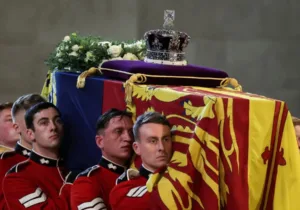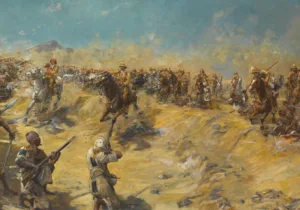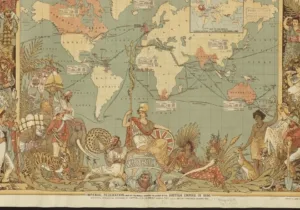On Saturday, Guy Fawkes Day was celebrated in Britain, as it has been since 1606. It recalls the discovery of the November 5, 1605 Gunpowder Plot by Guy Fawkes and others to blow up parliament and the king.
There is an ancient British nursery rhyme:
Remember, remember the Fifth of November,
The Gunpowder Treason and Plot,
I know of no reason
Why the Gunpowder Treason
Should ever be forgot.
Guy Fawkes, Guy Fawkes, t’was his intent
To blow up the King and Parli’ment.
Three-score barrels of powder below
To prove old England’s overthrow;
By God’s providence he was catch’d
With a dark lantern and burning match.
Holla boys, Holla boys, let the bells ring.
Holloa boys, holloa boys, God save the King!
The Gun Power Plot conspirators hoped to return Britain to Catholicism and alignment with continental Catholic powers like Spain. Typically, the day is celebrated with bonfires. In modern times, Guy Fawkes has become a popular villain, his mustached mask an icon for anarchy and rebellion.
As an icon, Fawkes is now cute and whimsical. But of course, he and his conspirators were terrorists and attempted assassins. Their success would have been disastrous for Britain and the wider cause of liberty in the world. Britain, nearly unique in the world, had a robust and fairly independent parliament that could challenge arbitrary royal power. Within a few decades, the parliament would even launch a war against and behead the king. Relative liberty in Britain contrasted with more autocratic Spain, for whom Fawkes fought in its war against the Protestant Netherlands.
Fawkes failed to get direct Spanish aid for insurrection in Britain, but he helped organize seditionists on his own. The explosion was intended to kill the “heretic” King James I, after which his nine-year-old daughter Elizabeth would become a Catholic queen who would return the natural order to Britain. Fawkes was discovered with 36 barrels of gunpowder beneath the House of Lords. Under torture he confessed his plans and the names of his co-conspirators. He died by hanging before he could be drawn and quartered while still alive. In death, his body parts were scattered throughout Britain as an example. King and parliament decreed that November 5 should be celebrated annually as a day of thanksgiving with bonfires and church services. A special liturgy was added to the Church of England’s Book of Common Prayer. Later, fireworks on the holiday became prominent, if also dangerous.
King James II, who was Catholic, unsuccessfully tried to suppress the commemoration. Auspiciously, William of Orange landed in England on November 5 to overthrow and replace James, and he gladly oversaw the full revival of the holiday. Guy Fawkes Day became enshrined as Britain’s chief national day of celebration. Britain has no equivalent of July 4 or Bastille Day. Today, Guy Fawkes Day has no legal standing but is the British equivalent of Halloween as a quirky folk holiday.
Guy Fawkes Day has across centuries often included anti-Catholic themes and effigies of the pope. But in recent times those themes have mostly if not entirely faded. Anti-Catholicism today is likelier to come from secularists than from Protestants. But the day has been central to Britain’s unfolding self-identity as independent, self-governing, defiant, free from domestic and external tyranny.
Many American colonials celebrated Guy Fawkes Day as part of their British Protestant heritage. During the American Revolution, George Washington forbade it among his soldiers for its propensity towards anti-Catholic bigotry, offensive by itself, but also a threat to potential alliance with French Quebecers, and later, France. Yet the themes of Guy Fawkes Day, chiefly independence, and liberty, obviously were central to revolutionary Americans own self-identity. America like Britain, saw itself as a providential nation incarnating freedom not only for itself but also as a beacon to other people less fortunate across the seas.
Guy Fawkes’s success on November 5 could have been Britain’s September 11, if the 9-11 conspirators had succeeded in decapitating the U.S. government by smashing the Capitol or The White House. Divine Providence prevented these calamities.
Here’s part of the Church of England liturgy for Guy Fawkes Day, which was deleted in 1859, as the holiday, which often because raucous, was deemed dangerous to civil order and sometimes offensive to Catholics:
ETERNAL God, and our most mighty Protector, we thy unworthy servants do humbly present ourselves before thy Majesty, acknowledging thy power, wisdom and goodness, in preserving the King, and the Three Estates of the Realm of England assembled in Parliament, from the destruction this day intended against them. Make us, we beseech thee, truly thankful for this, and for all other thy great mercies towards us; particularly for thy making this day against memorable, by a fresh instance of thy loving kindness towards us.
And:
Let truth and justice, brotherly kindness and charity, devotion and piety, concord and unity, with all other virtues, so flourish among us, that they may be the stability of our times, and make this Church a praise in the earth. All which we humbly beg for the sake of our blessed Lord and Savior.
Amen indeed.






